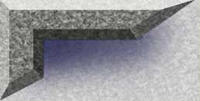|
|  |
|
Jewish Art
The greatest contribution of Jewish art came from a concentration camp called Theresienstadt; it was here that the Nazis put most of the Jewish artists of the time. Using stolen materials, these brave artists set about depicting camp life as it unfolded around them. They were eventually caught and sent to Auschwitz, some of their works were found; others were hidden and retrieved after the war. Taken together they are poignant look into the unimaginable life that they endured. This section is devoted to these brave artists whose art was undeniably influenced by the world around them.
Painters of Terezin (link) "Eternally Unfinished Art" Paintings and drawings from Terezin "Unique evidence in Holocaust history are five paintings, drawn by different artists on the same day, depicting the procession of the Bialystok children walking through Terezin. Unaware of each other, these artists drew the childrens arrival, each recording this unusual event in his own style." "Fragments of Memory"
Here are the five paintings, move the cursor over the painting to reveal the artist. 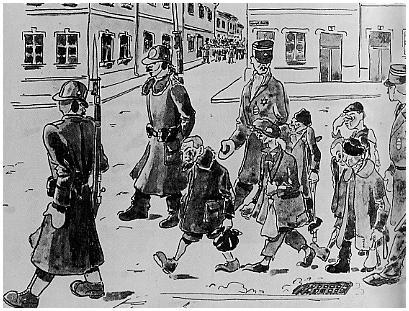
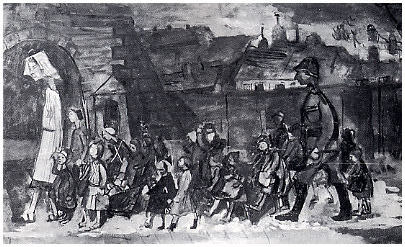
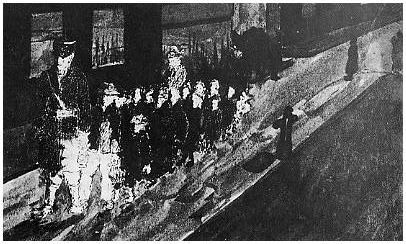
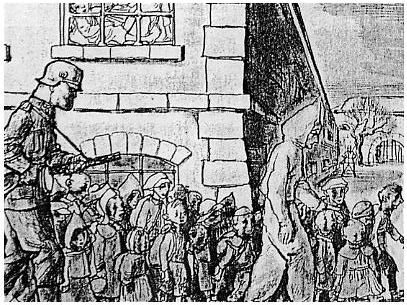
To learn more about Leo Haas click here to go the Museum of Tolerance 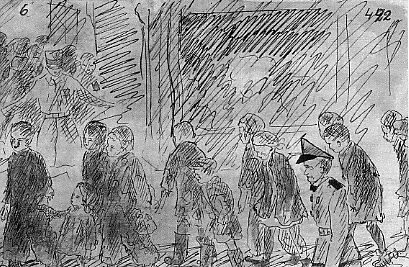
More on Pavel Fantel, Ernest Morgan and Helga Hoskova. (link)
|
 |
|
Otto Unger
Otto Unger was born November 27, 1901, in Brno, Moravia. As a young man he studied in Prague at the Academy of Creative Arts. After graduation he got a job at a Jewish High School in Brno, teaching painting, mathematics and geometry. In 1942 he and his family were deported in a transport to Terezin, where he worked in the Graphic Department, together with other artists from across Europe. He succeeded in hiding several of his paintings some of which were smuggled out of the ghetto and hidden in Prague. The Nazis found some of his work and that of other painters. They were arrested, interrogated and brutally tortured. Unger was then sent to Birkenau, upon liberation in April 1945, he was hospitalized in a town near Weimar, suffering from severe tuberculosis he died in July 1945.
A list of Unger's Work
The Blind
The Laundry
The Hunchback.
An Old Man.
On the backside: A couple of old people.
A street with barracks
A sitting Woman.
Hospital
|  |
|
Leo Haas
Leo Haas was born in Opava, Czechoslovakia on April 15, 1901. Haas had attained recognition as a famous painter before the war. After the occupation of Poland by the Nazis, he was sent to Nisko; in 1942 he arrived in Terezin and joined the Graphic Department. Along with Unger, Bloch and Fritta they produced stunning drawings and paintings that reflect the harsh conditions in which they lived.
Leo Haas testified: " We were four painters in a working group. Sometimes at night we have painted starving prisoners, transports of old people, the view of the hangings in the ghetto we have built a hiding place for these paintings. On July 17, 1944 - Ferdinand Bloch, Otto Unger, Bedrich Fritta and me - were arrested and taken from Terezin to the Small Fortress, accused of distribution of anti-nazi propaganda. There we were taken to a dungeon, interrogated and severely tortured. Ferdinand Bloch died shortly after it, Otto Unger was a victim of the Buchenwald camp and Bedrich Fritta was murdered in Birkenau. I was liberated in the camp Ebensee, in May 1945."
After the liberation, Leo Haas returned to Terezin and succeeded to find many of the hidden paintings.
A List of Haas Work
The girl and the other woman.
Caricature of Eng. Fischer, 1944.
Transport in winter.
Bakery.
One week of garment cleaning".
Georg Lustig in the bakery.
Caricature of Mirko Tuma, 1944
Portrait of a woman
|
 |
|
|
 |
|
|
|
|
FEAR
Today the ghetto knows a different fear,
Close in its grip, Death wields an icy scythe.
An evil sickness spreads a terror in its wake,
The victims of its shadow weep and writhe.
Today a fathers heartbeat tells his fright
And mothers bend their heads into their hands.
Now children choke and die with typhus here,
A bitter tax is taken from their bands.
My heart still beats inside my breast
While friends depart for other worlds.
Perhaps its better-who can say?
Than watching this, to die today?
No, no, my God, we want to live!
Not watch our numbers melt away.
We want to have a better world,
We want to work-we must not die!
Taken from "I have not seen a butterfly around here", is a poem written by a 14 year old child of Terezin named Eva Pickova.
|
|
|  |
